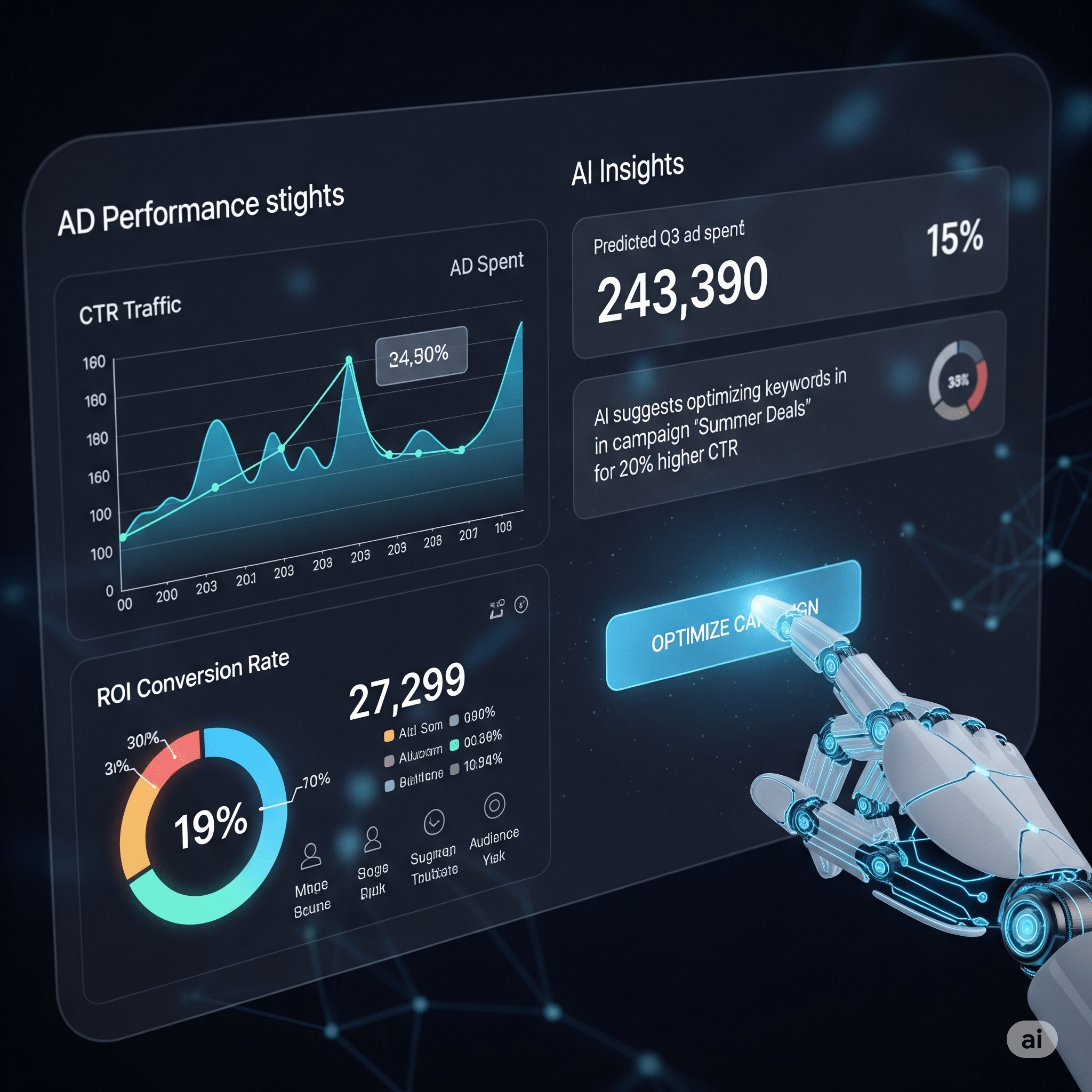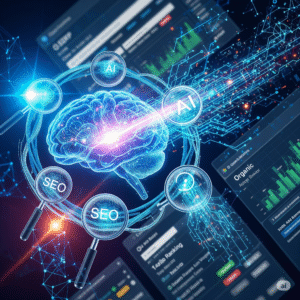Imagine a world where your paid advertising campaigns don’t just run—they learn. They adapt in real time. They predict customer behavior before it happens. This isn’t a sci-fi fantasy; it’s the reality of AI in paid ads, and it’s no longer a trend—it’s the new standard for success.
The landscape of digital advertising is evolving at an unprecedented pace, largely thanks to the integration of artificial intelligence for paid ads strategies. Marketers are moving past manual A/B testing and static targeting to embrace a future where machines handle the heavy lifting, freeing up human expertise for strategy and creativity. In 2025, if you’re not using AI in paid ads, you’re not just behind the curve—you’re at a significant disadvantage.
This isn’t about replacing human marketers. It’s about empowering them with tools that can process vast datasets, identify patterns, and execute optimizations at a scale and speed that no human team ever could. So, how exactly is this powerful technology reshaping the industry, and more importantly, how can you leverage it to dominate your market? Let’s dive in.
Redefining the Rulebook: How AI in Paid Ads is Powering Performance
The core of traditional paid advertising relies on a set of rules: targeting demographics, setting bids, and manually optimizing campaigns. But what happens when the rules are constantly being rewritten by a system that learns from millions of data points every second? The answer is a dramatic improvement in performance.
AI in paid ads excels in three key areas that were once the biggest headaches for marketers:
- Audience Targeting & Personalization: AI can go beyond simple demographics to build hyper-specific audience segments based on intent, online behavior, and even emotional triggers. It can then serve highly personalized ad creatives that resonate with each individual user.
- Automated Bidding & Budget Optimization: Tools like Google’s Smart Bidding and Performance Max use machine learning to predict which auctions are most likely to result in a conversion, then bid accordingly. This ensures your budget is spent on the highest-value opportunities.
- Dynamic Creative Optimization (DCO): Instead of creating a single ad, DCO powered by AI generates thousands of variations of an ad in real-time, swapping out headlines, images, and calls to action based on what performs best for each user.
This fusion of data, speed, and precision leads to tangible results, as we’ll see in the following case studies.
Real-World Application: Case Studies of AI in Paid Ads
The proof is in the numbers. Real companies are already achieving massive returns on investment by embracing AI in paid ads.
Case Study 1: The Harley-Davidson NYC Lead Generation Engine
Harley-Davidson’s New York City dealership faced a common marketing challenge: generating qualified leads efficiently. They turned to an AI-powered marketing platform called Albert.ai to automate and optimize their digital advertising across multiple channels. The AI system dynamically adjusted targeting, creative, and budget allocation in real-time based on performance signals. The outcome was nothing short of staggering: a 2,930% increase in leads and a 40% decrease in cost per lead. This case study shows how an intelligent system can act as a force multiplier, driving exponential impact that would be impossible to achieve manually.
Case Study 2: A Travel Agency’s High-Flying Success
A leading travel agency used machine learning algorithms to optimize their ad placements. By analyzing vast amounts of user behavior and preferences, the AI system could accurately predict which ad placements would be most effective. This proactive approach resulted in significantly higher click-through rates and improved conversion rates. The agency was able to move from a reactive marketing strategy, where they waited for results to come in, to a predictive one, where they could anticipate trends and position their ads for maximum success before the competition even caught on.
These examples clearly demonstrate that adopting AI in paid ads is not just about efficiency; it’s about a new level of strategic capability that drives immediate, measurable revenue growth.
Essential AI Tools for Paid Ads Strategies
To get started with artificial intelligence for paid ads strategies, you don’t need to be a data scientist. There are numerous user-friendly tools that can help you harness the power of AI. Here are a few recommendations to consider:
- AdCreative.ai: This platform uses machine learning to generate high-converting ad creatives at scale, helping you save time and outperform competitors.
- Jasper.ai: While not exclusively for ads, this generative AI tool is a copywriting powerhouse that can assist in writing compelling ad copy, headlines, and calls to action.
- Albert.ai: As seen in our case study, Albert.ai is a self-learning digital marketing platform that automates and optimizes campaigns across channels, from keyword research to ad spend.
- Smartly.io: This platform is designed to enhance social media marketing by offering AI-powered solutions for creative, media buying, and audience intelligence.
Incorporating even one of these tools into your workflow can provide an immediate boost to your paid ads performance.
AI in Social Media: The Social Media Game Changer in 2025
How-To & Tips: Getting Started with AI in Paid Ads
Adopting AI in paid ads doesn’t have to be intimidating. Start with a beginner-friendly workflow and build from there.
- Define a Clear Goal: Before you start, know what you want to achieve. Is it higher lead volume? A lower cost-per-acquisition? A bigger return on ad spend (ROAS)? Your AI will perform best when given a clear objective.
- Start with Automation: Begin with small, manageable tasks. Use AI to automate your bid management on platforms like Google or Meta. These systems are incredibly powerful and can handle the bulk of your bidding strategy, ensuring your campaigns are always optimized for performance.
- Embrace Dynamic Creatives: Don’t just upload one ad. Provide the AI with a variety of headlines, descriptions, images, and videos. The system will then automatically assemble and test the best combinations for each audience segment, a process called dynamic creative optimization. This is a simple yet effective way to leverage AI.
- Analyze the Insights: AI doesn’t just run campaigns; it provides powerful insights. Regularly review the data and recommendations offered by your tools. The AI might uncover an audience segment you never considered or suggest a creative style that you wouldn’t have thought of on your own.
- Use AI for Content Creation: Use a tool like Jasper.ai or another generative AI to help with ad copy. Feed it your product details and target audience, and it can generate multiple high-performing headlines and descriptions in a fraction of the time.
By starting small and gradually expanding your use of AI in paid ads, you can build confidence and see measurable results without a massive learning curve.
The Human Element: Strategy and Ethical Considerations
While AI handles the execution, the human strategist is more important than ever. Your job is to define the big-picture goals, understand your brand identity, and interpret the data to inform larger marketing strategies.
This shift also brings a new set of ethical responsibilities. AI systems rely on data, and biased data can lead to biased outcomes. Marketers must be mindful of how they collect and use data to avoid reinforcing stereotypes or excluding certain audience segments. As a recent McKinsey report highlights, organizations are now prioritizing the mitigation of risks like inaccuracy and intellectual property infringement.
Similarly, a HubSpot article on AI in digital marketing emphasizes the need for a clear governance model and a strong focus on data privacy to ensure that AI is used responsibly and ethically. The future of paid advertising is a partnership between human creativity and machine intelligence, with the human in the driver’s seat.
Conclusion: The Future of Paid Ads is Now
The rapid evolution of AI in paid ads is not just about new technologies—it’s about a fundamental change in how we approach digital advertising. The era of manual optimization is over, replaced by a dynamic, intelligent system that continuously learns and improves. By embracing tools and strategies that leverage artificial intelligence for paid ads strategies, you can create more personalized, efficient, and ultimately more profitable campaigns.
The shift is happening now, and the marketers who understand and adapt will be the ones who thrive in 2025 and beyond. Don’t be left behind. Start exploring how AI in paid ads can transform your marketing efforts today.
Keyword List: AI in Paid Ads, Artificial Intelligence for Paid Ads strategies, AI marketing tools, programmatic advertising, dynamic creative optimization, Smart Bidding, Performance Max, AI in advertising
AI in Content Marketing: The Ultimate Transformation for 2025



